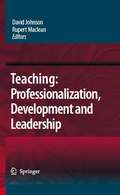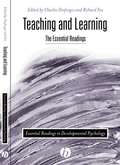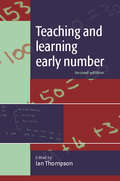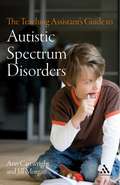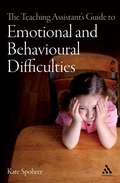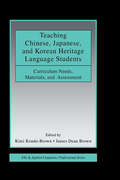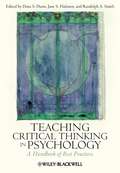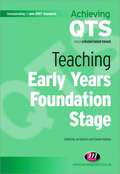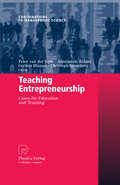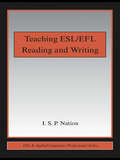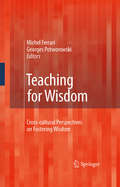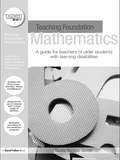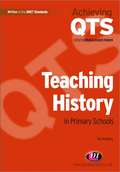- Table View
- List View
Teaching: Festschrift for Professor Eric Hoyle
by David Johnson Rupert MacleanThis book addresses central issues in the professionalisation and deprofessionalisation of teachers. It tackles these issues from different perspectives and in relation to different contexts. The book analyses new managerialism. It also considers possible solutions to two problems in particular: how to achieve accountability without intensification, and how to ensure that school management and leadership functions to support and enhance teachers as professionals.
Teaching and Learning: The Essential Readings (Essential Readings in Developmental Psychology)
by Charles Desforges Richard FoxThis is the first collection of key articles on the psychology behind educational attainment. It brings together in one volume for students a set of accessible but influential papers, representing the best classic and cutting edge work in the field.
Teaching and Learning Early Number (UK Higher Education OUP Humanities & Social Sciences Education OUP)
by Ian Thompson"This richly varied text offers generous support for every aspect of the teacher's role, while constantly reminding us that mathematical activity is not a de-contextualised skill that children possess, but part of their identity, their way of being in the world, engaged with the world, energetically - and playfully - trying to make sense of it."Mary Jane Drummond, formerly of the Faculty of Education, University of Cambridge, UKTeaching and Learning Early Number is a bestselling guide for all trainee and practising Early Years teachers and classroom assistants. It provides an accessible guide to a wide range of research evidence about the teaching and learning of early number.Major changes in the primary mathematics curriculum over the last decade - such as the National Numeracy Strategy, the Primary National Strategy, the Early Years Foundation Stage and the Williams Review - have greatly influenced the structure of this new edition. The book includes: A new introductory chapter to set the scene Six further new chapters - including Mathematics through play, Children's mathematical graphics and Interview-based assessment of early number knowledge Six completely re-written chapters and two updated chapters A new concluding chapter looking to the futureThe chapters can be read in a standalone fashion and many are cross referenced to other parts of the book where specific ideas are dealt with in a different manner. Issues addressed include: new research on the complex process of counting and on children's written mathematical marks; counting in the home environment and play in the school setting; the importance of mathematical representations and of ICT in children's understanding of number; errors and misconceptions and the assessment of children’s number knowledge.
The Teaching Assistant's Guide to Autistic Spectrum Disorders (Teaching Assistant's Series)
by Ann Cartwright Jill MorganA practical guide that will enable Teaching Assistants to understand the difficulties experienced by children on the Autistic Spectrum.
The Teaching Assistant's Guide to Emotional and Behavioural Difficulties (Teaching Assistant's Series)
by Kate SpohrerThis practical guide gives essential advice on: understanding emotional and behavioural problems; building good communication skills; managing behaviour in the classroom and developing an effective learning environment. Throughout each chapter there are exercises or questions to facilitate embedding knowledge and skills. At the end of each chapter there are multiple choice quizzes for you to reflect on what you have learned.
The Teaching Assistant's Guide to Emotional and Behavioural Difficulties (Teaching Assistant's Series)
by Kate SpohrerThis practical guide gives essential advice on: understanding emotional and behavioural problems; building good communication skills; managing behaviour in the classroom and developing an effective learning environment. Throughout each chapter there are exercises or questions to facilitate embedding knowledge and skills. At the end of each chapter there are multiple choice quizzes for you to reflect on what you have learnt.
Teaching Authentic Language Arts in a Test-Driven Era
by Arthur T. CostiganMost pre-service education students are enthusiastic about the progressive, constructivist, and student-centered theory and practice advocated in many teacher education programs and by the National Council of Teachers of English. Yet in actual day-to-day practice, teachers often have trouble thinking of ways in which such student-centered and constructivist practices in literacy instruction can be implemented in classrooms which are increasingly driven by high stakes tests, increased accountability, and mandated and even 'teacher proof' scripted curricula. Teaching Authentic Language Arts in a Test-Driven Era provides a powerful and much-needed counterargument to the assumption that test-driven curricula preclude meaningful instruction and authentic student engagement within a Language Arts curriculum. Providing teachers with the theoretical stances and pedagogicals tools to develop a Language Arts practice which can be personally rewarding as well as beneficial to students,Teaching Authentic Language Arts in a Test-Driven Era empowers teachers to be effective even within the confines of a testing- and accountability-driven curriculum.
Teaching Authentic Language Arts in a Test-Driven Era
by Arthur T. CostiganMost pre-service education students are enthusiastic about the progressive, constructivist, and student-centered theory and practice advocated in many teacher education programs and by the National Council of Teachers of English. Yet in actual day-to-day practice, teachers often have trouble thinking of ways in which such student-centered and constructivist practices in literacy instruction can be implemented in classrooms which are increasingly driven by high stakes tests, increased accountability, and mandated and even 'teacher proof' scripted curricula. Teaching Authentic Language Arts in a Test-Driven Era provides a powerful and much-needed counterargument to the assumption that test-driven curricula preclude meaningful instruction and authentic student engagement within a Language Arts curriculum. Providing teachers with the theoretical stances and pedagogicals tools to develop a Language Arts practice which can be personally rewarding as well as beneficial to students,Teaching Authentic Language Arts in a Test-Driven Era empowers teachers to be effective even within the confines of a testing- and accountability-driven curriculum.
Teaching Chinese, Japanese, and Korean Heritage Language Students: Curriculum Needs, Materials, and Assessment (ESL & Applied Linguistics Professional Series)
by Kimi Kondo-Brown James Dean BrownThis book contributes to building the research knowledge that language teaching professionals need in developing curriculum for the large population of East Asian heritage students (including Chinese, Japanese, and Korean) in countries like the United States, Canada, and Australia, where speakers of East Asian languages are among the fastest growing populations. Heritage learners are defined as those who initially acquired certain levels of linguistic and cultural competence in a non-dominant language mainly through interaction with foreign-born parents and other family members at home. Heritage language instruction is currently a “hot topic” and is becoming a sub-discipline within the fields of foreign language education and applied linguistics. Special instruction for heritage language learners is on the rise, particularly in the U.S. and Canada. Providing theoretical and practical information about heritage-language instruction in terms of curriculum design, learner needs, materials development, and assessment procedures, the goal of this book is not only to promote research about heritage students in East Asian languages but also to improve the teaching of these students in various educational settings and all over the world, especially in English speaking countries. The volume is organized in four sections:*Overview—addressing the timeliness, necessity, and applications of the work and issues and future agendas for teaching Chinese, Japanese, and Korean heritage students;*Language Needs Analysis;*Attitude, Motivation, Identity, and Instructional Preference; and*Curriculum Design, Materials Development, and Assessment Procedures Teaching Chinese, Japanese, and Korean Heritage Language Students is intended as a primary text or reference for researchers, educators, and students in the areas of curriculum, pedagogy, and assessment studies related to teaching bilingual and heritage students in general and East Asian heritage students in particular.
Teaching Chinese, Japanese, and Korean Heritage Language Students: Curriculum Needs, Materials, and Assessment (ESL & Applied Linguistics Professional Series)
by Kimmi Kondo-Brown James Dean BrownThis book contributes to building the research knowledge that language teaching professionals need in developing curriculum for the large population of East Asian heritage students (including Chinese, Japanese, and Korean) in countries like the United States, Canada, and Australia, where speakers of East Asian languages are among the fastest growing populations. Heritage learners are defined as those who initially acquired certain levels of linguistic and cultural competence in a non-dominant language mainly through interaction with foreign-born parents and other family members at home. Heritage language instruction is currently a “hot topic” and is becoming a sub-discipline within the fields of foreign language education and applied linguistics. Special instruction for heritage language learners is on the rise, particularly in the U.S. and Canada. Providing theoretical and practical information about heritage-language instruction in terms of curriculum design, learner needs, materials development, and assessment procedures, the goal of this book is not only to promote research about heritage students in East Asian languages but also to improve the teaching of these students in various educational settings and all over the world, especially in English speaking countries. The volume is organized in four sections:*Overview—addressing the timeliness, necessity, and applications of the work and issues and future agendas for teaching Chinese, Japanese, and Korean heritage students;*Language Needs Analysis;*Attitude, Motivation, Identity, and Instructional Preference; and*Curriculum Design, Materials Development, and Assessment Procedures Teaching Chinese, Japanese, and Korean Heritage Language Students is intended as a primary text or reference for researchers, educators, and students in the areas of curriculum, pedagogy, and assessment studies related to teaching bilingual and heritage students in general and East Asian heritage students in particular.
Teaching Critical Thinking in Psychology: A Handbook of Best Practices
by Dana S. Dunn Jane S. Halonen Randolph A. SmithTeaching Critical Thinking in Psychology features current scholarship on effectively teaching critical thinking skills at all levels of psychology. Offers novel, nontraditional approaches to teaching critical thinking, including strategies, tactics, diversity issues, service learning, and the use of case studies Provides new course delivery formats by which faculty can create online course materials to foster critical thinking within a diverse student audience Places specific emphasis on how to both teach and assess critical thinking in the classroom, as well as issues of wider program assessment Discusses ways to use critical thinking in courses ranging from introductory level to upper-level, including statistics and research methods courses, cognitive psychology, and capstone offerings
Teaching Early Years Foundation Stage
by Jo Basford Elaine HodsonThe Early Years Foundation Stage (EYFS) came into force in September 2008 and established a framework for providing learning, development and care for children from birth to five. This book examines the EYFS within the context of Achieving QTS and is a core text for primary trainees covering this stage of children's learning. It links the principles and commitments of the EYFS with the new standards for QTS while covering all required content. The book examines the continuous nature of learning from birth to five, the inter-relatedness between care, learning and development, and the importance of sensitive transitions.
Teaching Early Years Foundation Stage
by Elaine Hodson Mrs Jo BasfordThe Early Years Foundation Stage (EYFS) came into force in September 2008 and established a framework for providing learning, development and care for children from birth to five. This book examines the EYFS within the context of Achieving QTS and is a core text for primary trainees covering this stage of children's learning. It links the principles and commitments of the EYFS with the new standards for QTS while covering all required content. The book examines the continuous nature of learning from birth to five, the inter-relatedness between care, learning and development, and the importance of sensitive transitions.
Teaching Early Years Foundation Stage (PDF)
by Jo Basford Elaine HodsonThe Early Years Foundation Stage (EYFS) came into force in September 2008 and established a framework for providing learning, development and care for children from birth to five. This book examines the EYFS within the context of Achieving QTS and is a core text for primary trainees covering this stage of children's learning.
Teaching Entrepreneurship: Cases for Education and Training (Contributions to Management Science)
by Peter Van Der Sijde Annemarie Ridder Gerben Blaauw Christoph Diensberg“Entrepreneurship that is something you learn in practice”. “Entreprene- ship is learning by doing”. This is often heard when you tell others that you teach entrepreneurship, but maybe entrepreneurship is more “doing by learning”. Nevertheless, in entrepreneurship practice and theory are int- woven. For this reason the Learning Cycle introduced by Kolb (1984) is an often used teaching approach. According to this Learning Cycle there are four phases (“cycle”) that are connected: 1. Concrete experience (“doing”, “experiencing”) 2. Reflection (“reflecting on the experience”) 3. Conceptualization (“learning from the experience”) 4. Experimentation (“bring what you learned into practice”) In teaching you can enter this cycle at any stage, depending on the students. And that brings us to the different types of students. Based on Hills et al. (1998) a plethora of student groups can be distinguished (of course this list is not exhaustive), e.g: Ph.D. students, who do a doctoral programme in Entrepreneurship; the emphasis is on theory/science. DBA students, who do a doctoral programme that is, in comparison to the Ph.D. more practice oriented. MBA students, who take entrepreneurship as one of the courses in their programme. Most of the time MBA students are mature students, who after some work experience return to the university; the programme is practice oriented.
Teaching ESL/EFL Reading and Writing (ESL & Applied Linguistics Professional Series)
by I.S.P. NationUsing a framework based on principles of teaching and learning, this guide for teachers and teacher trainees provides a wealth of suggestions for helping learners at all levels of proficiency develop their reading and writing skills and fluency. By following these suggestions, which are organized around four strands – meaning-focused input, meaning-focused output, language-focused learning, and fluency development – teachers will be able to design and present a balanced program for their students. Teaching ESL/EFL Reading and Writing, and its companion text, Teaching ESL/EFL Listening and Speaking, are similar in format and the kinds of topics covered, but do not need to be used together. Drawing on research and theory in applied linguistics, their focus is strongly hands-on, featuring easily applied principles, a large number of useful teaching techniques, and guidelines for testing and monitoring, All Certificate, Diploma, Masters and Doctoral courses for teachers of English as a second or foreign language include a teaching methods component. The texts are designed for and have been field tested in such programs.
Teaching for Wisdom: Cross-cultural Perspectives on Fostering Wisdom
by Michel Ferrari Georges PotworowskiThis book examines if it is possible to teach wisdom. It considers how people at different times and places have engaged the age-old question of how (or whether) we can learn to live a good life, and what that life is like. Offering a range of perspectives, coverage considers Greek and Confucian philosophy; Christian, Islamic and Buddhist religion; African tradition, as well as contemporary scientific approaches to the study of wisdom.
Teaching Foundation Mathematics: A Guide for Teachers of Older Students with Learning Difficulties (nasen spotlight)
by Nadia Naggar-SmithThis fully photocopiable resource will provide essential materials for anyone teaching pre-entry or foundation Maths in secondary schools and further education. Teaching Foundation Mathematics is developed to provide age appropriate material for adult learners with moderate to severe learning difficulties and/or disabilities and for children, over twelve, with special needs. It will also prove useful to teachers training to work with these learners. Thirty ready-to-use lessons are at your fingertips in this book, complete with tutor’s notes, teaching objectives, detailed lesson plans and photocopiable worksheets, where appropriate. The lessons are divided into three areas – number, shape and measure.
Teaching Foundation Mathematics: A Guide for Teachers of Older Students with Learning Difficulties (nasen spotlight)
by Nadia Naggar-SmithThis fully photocopiable resource will provide essential materials for anyone teaching pre-entry or foundation Maths in secondary schools and further education. Teaching Foundation Mathematics is developed to provide age appropriate material for adult learners with moderate to severe learning difficulties and/or disabilities and for children, over twelve, with special needs. It will also prove useful to teachers training to work with these learners. Thirty ready-to-use lessons are at your fingertips in this book, complete with tutor’s notes, teaching objectives, detailed lesson plans and photocopiable worksheets, where appropriate. The lessons are divided into three areas – number, shape and measure.
Teaching History: Developing as a Reflective Secondary Teacher (PDF)
by Ian PhillipsReflective practice is at the heart of effective teaching, and this book will help you develop into a reflective teacher of history. Everything you need is here: guidance on developing your analysis and self-evaluation skills, the knowledge of what you are trying to achieve and why, and examples of how experienced teachers deliver successful lessons.
Teaching History
by Pat HoodlessThis book introduces trainees and newly qualified teachers to the teaching of history in primary schools, and covers key concepts, skills and knowledge for the history curriculum at Foundation Stage, KS1 and KS2. Contents include planning, teaching and learning strategies, assessment, reflection and evaluation, as well as a range of practical ideas for classroom activities and cross-curricular themes. Each chapter is underpinned by national and international research; also included are links to important themes such as citizenship, out-of-school learning, sustainability, diversity and inclusive practice. Throughout, content is related to new initiatives such as Every Child Matters and Excellence and Enjoyment.
Teaching History: Developing as a Reflective Secondary Teacher
by Ian PhillipsReflective practice is at the heart of effective teaching, and this book will help you develop into a reflective teacher of history. Everything you need is here: guidance on developing your analysis and self-evaluation skills, the knowledge of what you are trying to achieve and why, and examples of how experienced teachers deliver successful lessons. The book shows you how to plan lessons, how to make the best use of resources and how to assess pupils' progress effectively. Each chapter contains points for reflection, which encourage you to break off from your reading and think about the challenging questions that you face as a history teacher. The book comes with access to a companion website, where you will find: - Videos of real lessons so you can see the skills discussed in the text in action - Transcripts from teachers and students that you can use as tools for reflection - Links to a range of sites that provide useful additional support - Extra planning and resource materials. If you are training to teach history, citizenship or social sciences this book will help you to improve your classroom performance by providing you with practical advice, and also by helping you to think in depth about the key issues. It provides examples of the research evidence that is needed in academic work at Masters level, essential for anyone undertaking an M-level PGCE. Ian Phillips is course leader for PGCE History (and Teaching and Learning Fellow) at Edge Hill University.
Teaching History: Developing as a Reflective Secondary Teacher (PDF)
by Ian PhillipsReflective practice is at the heart of effective teaching, and this book will help you develop into a reflective teacher of history. Everything you need is here: guidance on developing your analysis and self-evaluation skills, the knowledge of what you are trying to achieve and why, and examples of how experienced teachers deliver successful lessons. The book shows you how to plan lessons, how to make the best use of resources and how to assess pupils' progress effectively. Each chapter contains points for reflection, which encourage you to break off from your reading and think about the challenging questions that you face as a history teacher. The book comes with access to a companion website, where you will find: - Videos of real lessons so you can see the skills discussed in the text in action - Transcripts from teachers and students that you can use as tools for reflection - Links to a range of sites that provide useful additional support - Extra planning and resource materials. If you are training to teach history, citizenship or social sciences this book will help you to improve your classroom performance by providing you with practical advice, and also by helping you to think in depth about the key issues. It provides examples of the research evidence that is needed in academic work at Masters level, essential for anyone undertaking an M-level PGCE. Ian Phillips is course leader for PGCE History (and Teaching and Learning Fellow) at Edge Hill University.
Teaching History in Primary Schools
by Pat HoodlessThis book introduces trainees and newly qualified teachers to the teaching of history in primary schools, and covers key concepts, skills and knowledge for the history curriculum at Foundation Stage, KS1 and KS2. Contents include planning, teaching and learning strategies, assessment, reflection and evaluation, as well as a range of practical ideas for classroom activities and cross-curricular themes. Each chapter is underpinned by national and international research; also included are links to important themes such as citizenship, out-of-school learning, sustainability, diversity and inclusive practice. Throughout, content is related to new initiatives such as Every Child Matters and Excellence and Enjoyment.
Teaching History Online
by John F. LyonsBringing history teaching into the twenty-first century, Teaching History Online is a concise guide to developing and using internet resources in history instruction. It offers practical, jargon-free advice to help the history teacher develop online assignments, and provides an informed introduction to the myriad resources and tools available for use in the online classroom. Beginning with a chapter on the benefits of teaching and studying online, John F. Lyons goes on to address instructors’ most commonly asked questions and concerns, including: designing an online class providing online alternatives to the lecture developing a user-friendly discussion board conducting assessment and dealing with classroom management issues. For historians interested in providing an online element to their traditional face-to-face classroom teaching, the final chapter shows how to develop successful hybrid/blended classes. An accessible introduction and valuable resource, Teaching History Online includes sample lesson plans, examples of online learning tools, and suggestions for further reading, helping those who use – or want to use – online resources to create exciting, interactive and rewarding learning environments. Visit the companion website, which includes extra reading and resources information at: www.routledge.com/textbooks/9780415482226.
